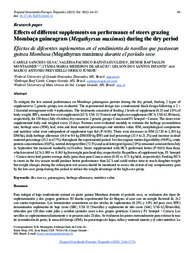Effects of different supplements on performance of steers grazing Mombaça guineagrass (Megathyrsus maximus) during the dry period.
Effects of different supplements on performance of steers grazing Mombaça guineagrass (Megathyrsus maximus) during the dry period.
Autoria: SILVA, C. S.; EUCLIDES, V. P. B.; MONTAGNER, D. B.; ARAÚJO, I. M. M. de; DIFANTE, G. dos S.; ORRICO JUNIOR, M. A. P.
Resumo: ABSTRACT - To mitigate the low animal performance on Mombaça guineagrass pasture during the dry period, feeding 2 types of supplement to 2 genetic groups was evaluated. The experimental design was a randomized block design following a 2 × 2 factorial arrangement with 4 replications. The treatments consisted of feeding 2 levels of supplement (0.25 and 1.0% of body weight; BW), named low-cost supplement (LCS; US$ 11.75/steer) and high-cost supplement (HCS; US$ 62.80/steer), respectively, for 130 days (July–October; dry season) to 2 genetic groups: Caracu and F1 Senepol × Caracu. The steers were supplemented daily and weighed every 28 days. Pastures were evaluated monthly to estimate the herbage accumulation rate, herbage mass (HM), leaf, stem and dead material percentages and nutritive value. HM, morphological components and nutritive value were independent of supplement type fed (P>0.05). There were decreases in HM (3,720 to 3,205 kg DM/ha), daily herbage allowance (14.0 to 9.4 kg DM/100 kg BW) and leaf percentage (33.4 to 21.2%) and increase in dead material percentage (53.3 to 67.7%) throughout the experimental period. In vitro organic matter digestibility (59.9%), crude protein concentration (10.0%), neutral detergent fiber (72.1%) and acid detergent lignin (2.9%) remained constant from July to September but increased markedly in October. Steers supplemented with HCS performed better (P<0.05) than those which received LCS (1.005 vs. 0.565 kg liveweight gain/head/day, respectively). Regardless of supplement type, F1 Senepol × Caracu steers had greater average daily gains than pure Caracu steers (0.88 vs. 0.71 kg/hd/d, respectively). Feeding HCS to steers in the dry season would produce better performance than LCS and could reduce time to reach slaughter weight but weight changes during the subsequent wet season should be monitored to assess the extent of any compensatory gain by the low-cost group during this period to reduce the weight advantage of the high-cost group.
Ano de publicação: 2021
Tipo de publicação: Artigo de periódico
Unidade: Embrapa Gado de Corte
Palavras-chave: Bos Taurus, Dry season, Forage production, Megathyrsus maximus, Nutritive value, Seca, Steers, Tropical pastures, Valor Nutritivo
Observações
1 - Por padrão são exibidas publicações dos últimos 20 anos. Para encontrar publicações mais antigas, configure o filtro ano de publicação, colocando o ano a partir do qual você deseja encontrar publicações. O filtro está na coluna da esquerda na busca acima.
2 - Para ler algumas publicações da Embrapa (apenas as que estão em formato ePub), é necessário ter, no celular ou computador, um desses softwares gratuitos. Sistemas Android: Google Play Livros; IOS: iBooks; Windows e Linux: software Calibre.
Acesse outras publicações
Acesse a Base de Dados da Pesquisa Agropecuária (BDPA) para consultar o acervo completo das bibliotecas da Embrapa.

